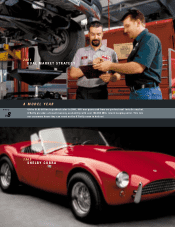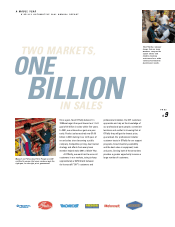O'Reilly Auto Parts 2001 Annual Report Download - page 20
Download and view the complete annual report
Please find page 20 of the 2001 O'Reilly Auto Parts annual report below. You can navigate through the pages in the report by either clicking on the pages listed below, or by using the keyword search tool below to find specific information within the annual report.
O’REILLY AUTOMOTIVE 2001 ANNUAL REPORT
A MODEL YEAR
Page 18
related to the opening of new stores, as well as the relocation or
remodeling of existing stores. We opened 121, 101 and 80 net stores
in 2001, 2000 and 1999, respectively. We also acquired 82 stores in
connection with the purchase of Mid-State, effective October 1, 2001.
We remodeled or relocated 16 stores in 2001 and 8 stores in both
2000 and in 1999. Four new distribution centers were acquired: two
in October 2001, located in Nashville, Tennessee, and Knoxville,
Tennessee; one in October 2000, located in Little Rock, Arkansas;
and the other in December 1999, located in Dallas, Texas.
Our continuing store expansion program requires significant
capital expenditures and working capital principally for inventory
requirements. The costs associated with the opening of a new store
(including the cost of land acquisition, improvements, fixtures,
inventory and computer equipment) are estimated to average
approximately $900,000 to $1.1 million; however, such costs may
be significantly reduced where we lease, rather than purchase,
the store site. Although the cost to acquire the business of an
independently owned parts store varies, depending primarily
upon the amount of inventory and the amount, if any, of real estate
being acquired, we estimate that the average cost to acquire such
a business and convert it to one of our stores is approximately
$400,000. We plan to finance our expansion program through cash
expected to be provided from operating activities and available
borrowings under our existing credit facilities.
On November 4, 1999, the Board of Directors declared a
two-for-one stock split effected in the form of a 100% stock dividend
to all shareholders of record as of November 15, 1999. The stock
dividend was paid on November 30, 1999.
In March 1999, we sold 7,002,000 shares of common stock
through a secondary public offering. The net proceeds from that
offering, which amounted to $124.6 million, were used to repay a
portion of our outstanding indebtedness under our bank credit
facilities and to fund our expansion.
In order to fund the Hi/Lo acquisition, our continuing store
expansion program, and our working capital and general corporate
needs, we replaced our lines of credit in January 1998 with an
unsecured, five-year syndicated credit facility of $175 million.
The credit facility was reduced to $165 million in 1999, $152.5 million
in 2000 and $140 million in 2001. The facility is currently comprised
of a revolving credit facility of $125 million and a term loan of
$15 million. The credit facility is guaranteed by all of our subsidiaries.
At December 31, 2001 and 2000, $61,350,000 and $74,755,000,
respectively, of the revolving credit facility and $15 million and
$27.5 million, respectively, of the term loan were outstanding. The
credit facility, which bears interest at LIBOR plus 0.50% (2.43% at
December 31, 2001), expires in January 2003.
Our contractual obligation, including commitments for future
payments under non-cancelable lease arrangements and short
and long-term debt arrangements, are summarized below and
are fully disclosed in Notes 5, 6 and 7 to the consolidated financial
statements. We have not participated in, nor secured financings
for any unconsolidated special purpose entities.
(In thousands)
LESS
THAN 2-3 4-5 AFTER
PAYMENTS DUE BY PERIOD TOTAL 1 YEAR YEARS YEARS 5 YEARS
Notes payable $ 5,165 $ 5,074 $ 86 $ 5 $ –
Long-term debt 176,436 11,261 65,125 75,029 25,021
Capital lease obligations 860 509 351 – –
Operating leases 216,103 24,838 41,077 30,546 119,642
Unconditional
purchase commitments 22,349 22,349 – – –
Total contractual
cash obligations $420,913 $64,031 $106,639 $105,580 $144,663
We believe that our existing cash, short-term investments,
cash expected to be provided by operating activities, available bank
credit facilities and trade credit will be sufficient to fund both our
short-term and long-term capital needs for the foreseeable future.
INFLATION AND SEASONALITY
We succeeded, in many cases, in reducing the effects of merchandise
cost increases principally by taking advantage of vendor incentive
programs, economies of scale resulting from increased volume of
purchases and selective forward buying. As a result, we do not
believe that our operations have been materially affected by inflation.
Our business is somewhat seasonal, primarily as a result of the
impact of weather conditions on store sales. Store sales and profits
have historically been higher in the second and third quarters (April
through September) of each year than in the first and fourth quarters.
MANAGEMENT’S DISCUSSION AND ANALYSIS OF FINANCIAL CONDITION AND RESULTS OF OPERATIONS (CONTINUED)
























